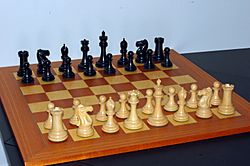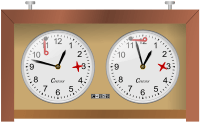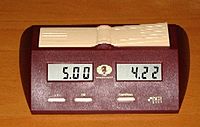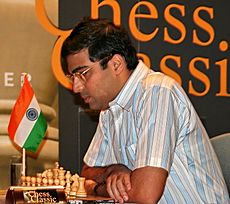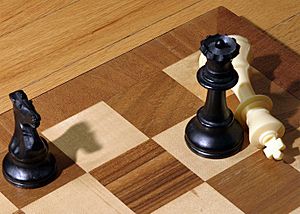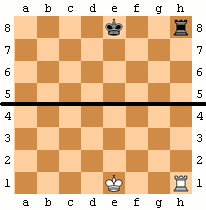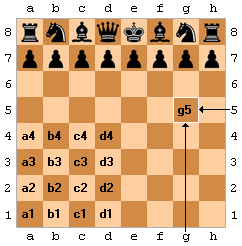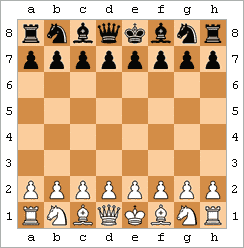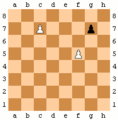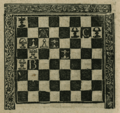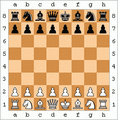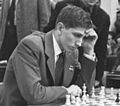Chess facts for kids
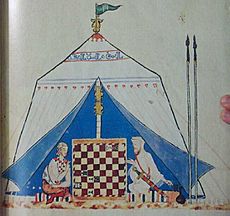
Chess is a board game for two players. It is played in a square board, made of 64 smaller squares, with eight squares on each side. Each player starts with sixteen pieces: eight pawns, two knights, two bishops, two rooks, one queen and one king. The goal of the game is for each player to try and checkmate the king of the opponent. Checkmate is a threat ('check') to the opposing king which no move can stop. It ends the game.
During the game the two opponents take turns to move one of their pieces to a different square of the board. One player ('White') has pieces of a light color; the other player ('Black') has pieces of a dark color. There are rules about how pieces move, and about taking the opponent's pieces off the board. The player with white pieces always makes the first move. Because of this, White has a small advantage, and wins more often than Black in tournament games.
Chess is popular and is often played in competitions called chess tournaments. It is enjoyed in many countries, and is a national hobby in Russia.
Magnus Carlsen is the World Chess Champion. He became World Champion on 22 November 2013, by defeating Viswanathan Anand. Carlsen also won the return match in 2014.
Contents
History
Most historians agree that the game of chess was first played in northern India during the Gupta Empire in the 6th century AD. This early type of chess was known as Chaturanga, a Sanskrit word for the military. The Gupta chess pieces were divided like their military into the infantry, cavalry, elephants, and chariots. In time, these pieces became the pawn, knight, bishop, and rook. The English words chess and check both come from the Persian word shāh meaning king.
The earliest written evidence of chess is found in three romances (epic stories) written in Sassanid Persia around 600AD. The game was known as chatrang or shatranj. When Persia was taken over by Muslims (633–644) the game was spread to all parts of the Muslim world. Muslim traders carried the game to Russia and to Western Europe. By the year 1000 it had spread all over Europe. In the 13th century a Spanish manuscript called Libro de los Juegos describes the games of shatranj (chess), backgammon, and dice.
The game changed greatly between about 1470 to 1495. The rules of the older game were changed in the West so that some of the pieces (queen, bishop) had more scope, development of the pieces was faster, and the game more exciting. The new game formed the basis of modern international chess. Historians of chess consider this as the most important change since the game was invented.
Rules
The rules of chess are governed by the World Chess Federation, which is known by the initials FIDE, meaning Fédération Internationale des Échecs. The rules are in the section Laws of Chess of the FIDE Handbook. FIDE also give rules and guidelines for chess tournaments.
Setup
Chess is played on a square board divided into eight rows of squares called ranks and eight columns called files, with a dark square in each player's lower left corner. This is altogether 64 squares. The colors of the squares are laid out in a checker (chequer) pattern in light and dark squares. To make speaking and writing about chess easy, each square has a name. Each rank has a number from 1 to 8, and each file a letter from a to h. This means that every square on the board has its own label, such as g1 or f5. The pieces are in white and black sets. The players are called White and Black, and at the start of a game each player has 16 pieces. The 16 pieces are one king, one queen, two rooks, two bishops, two knights and eight pawns. in this game out can get up to a quadruple pon, king, knight, queen, and also the king although it is very rare.
Movement
Definitions: vertical lines are files; horizontal lines are ranks; lines at 45° are diagonals. Each piece has its own way of moving around the board. The X marks the squares where the piece can move.
- The knight is the only piece that can jump over another piece.
- No piece may move to a square occupied by a piece of the same color.
- All pieces capture the same way they move, except pawns.
| a | b | c | d | e | f | g | h | ||
| 8 |

|
8 | |||||||
| 7 | 7 | ||||||||
| 6 | 6 | ||||||||
| 5 | 5 | ||||||||
| 4 | 4 | ||||||||
| 3 | 3 | ||||||||
| 2 | 2 | ||||||||
| 1 | 1 | ||||||||
| a | b | c | d | e | f | g | h | ||
| a | b | c | d | e | f | g | h | ||
| 8 |

|
8 | |||||||
| 7 | 7 | ||||||||
| 6 | 6 | ||||||||
| 5 | 5 | ||||||||
| 4 | 4 | ||||||||
| 3 | 3 | ||||||||
| 2 | 2 | ||||||||
| 1 | 1 | ||||||||
| a | b | c | d | e | f | g | h | ||
| a | b | c | d | e | f | g | h | ||
| 8 |

|
8 | |||||||
| 7 | 7 | ||||||||
| 6 | 6 | ||||||||
| 5 | 5 | ||||||||
| 4 | 4 | ||||||||
| 3 | 3 | ||||||||
| 2 | 2 | ||||||||
| 1 | 1 | ||||||||
| a | b | c | d | e | f | g | h | ||
| a | b | c | d | e | f | g | h | ||
| 8 |

|
8 | |||||||
| 7 | 7 | ||||||||
| 6 | 6 | ||||||||
| 5 | 5 | ||||||||
| 4 | 4 | ||||||||
| 3 | 3 | ||||||||
| 2 | 2 | ||||||||
| 1 | 1 | ||||||||
| a | b | c | d | e | f | g | h | ||
| a | b | c | d | e | f | g | h | ||
| 8 |

|
8 | |||||||
| 7 | 7 | ||||||||
| 6 | 6 | ||||||||
| 5 | 5 | ||||||||
| 4 | 4 | ||||||||
| 3 | 3 | ||||||||
| 2 | 2 | ||||||||
| 1 | 1 | ||||||||
| a | b | c | d | e | f | g | h | ||
| a | b | c | d | e | f | g | h | ||
| 8 |

|
8 | |||||||
| 7 | 7 | ||||||||
| 6 | 6 | ||||||||
| 5 | 5 | ||||||||
| 4 | 4 | ||||||||
| 3 | 3 | ||||||||
| 2 | 2 | ||||||||
| 1 | 1 | ||||||||
| a | b | c | d | e | f | g | h | ||
- The king's move is one square in any direction. The king (K for short) may not move to any square where it is threatened by an opposing piece. However, the king can move to a square that is occupied by an opponent's piece and capture the piece, taking it off the board.
- The queen (Q) can move any distance in any direction on the ranks, files and diagonals.
- The rooks (R) move any distance on the ranks or files.
- The bishops (B) move diagonally on the board. Since a bishop can only move diagonally, it will always be on the same color square.
- The knights (Kt or N) move in an "L" shape. Each move must be either two squares along a rank and one square along a file, or two squares along a file and one square along a rank. It is the only piece that can jump over other pieces. Like the other pieces, it captures an opposing piece by landing on its square.
- The pawns can only move up the board. On its first move a pawn may move either one or two squares forward. A pawn captures one square diagonally, not as it moves: see white circles on its diagram. Besides, in some situations pawns can capture opponent's pawns in a special way called en passant, which means in passing in French (see below).
Capturing
Most pieces capture as they move. If a piece lands on an opponent's piece, the opposing piece is taken off the board. There are three special cases:
- The king cannot be taken (see check and checkmate).
- No piece can be taken while castling (see below).
- Pawns take one square diagonally.
Check and checkmate
If a move is made which attacks the opposing king, that king is said to be 'in check'. The player whose king is checked must make a move to remove the check. The options are: moving the king, capturing the threatening piece, or moving another piece between the threatening piece and the king. If the player whose king is in danger cannot do any of these things, it is checkmate, and the player loses the game.
Special moves
Castling
Once in every game, each king can make a special move, known as castling. When the king castles, it moves two squares to the left or right. When this happens, the rook is moved to stand on the opposite side of the King. Castling is only allowed if all of these rules are kept:p120
- Neither piece doing the castling may have been moved during the game.
- There must be no pieces between the king and the rook.
- The king may not be currently in check, nor may the king pass through any square attacked by the opponent. As with any move, castling is not allowed if it would place the king in check.
En passant
| a | b | c | d | e | f | g | h | ||
| 8 |

|
8 | |||||||
| 7 | 7 | ||||||||
| 6 | 6 | ||||||||
| 5 | 5 | ||||||||
| 4 | 4 | ||||||||
| 3 | 3 | ||||||||
| 2 | 2 | ||||||||
| 1 | 1 | ||||||||
| a | b | c | d | e | f | g | h | ||
En passant ('in passing' in French) is a special capture. It is only available when a pawn moves forward two squares past an opposing pawn on an adjacent file. The opposing pawn must be on the 5th rank from its own side. Then the opponent's pawn can capture the double-mover as if it had only moved one square forward. This option is open on the next move only.
For example, if the black pawn has just moved up two squares from g7 to g5, then the white pawn on f5 can take it by en passant on g6. The en passant rule was developed when pawns were allowed to make their double move. The rule made it more difficult for players to avoid pawn exchanges and blockade the position. It kept the game more open.
Promotion
When a pawn moves to its eighth rank, it must be changed for a piece: a queen, rook, bishop, or knight of the same color (player's choice). Normally, the pawn is queened, but in some advantageous cases another piece is chosen, called 'under-promotion'.
Ways a game may end
Checkmates are rare in competitive chess. The most common ends are decisions made by one or both players.
Wins
- Checkmate. When a king is in check, and cannot get out of it.
- Resignation. A player may resign at any time, usually because his/her position is hopeless. A losing player is able to resign by placing their king on its side on the chessboard.
- Out of time. If player's clock time is over (exceeding the time control). Strictly speaking, this is not part of the rules of the game, but part of the rules of tournament and match chess where chess clocks are used.Chapter 8
Draws
- Draw agreed. A game may end in a draw at any time if one player offers a draw and the other accepts.
- Insufficient Material Or Dead Position . A position where no series of legal moves could lead to a mate (example: K+B vs K). The game is drawn.p92
- Stalemate. If a player cannot make a move, and the player's king is not in check, this is also a draw. This kind of draw is called a stalemate, and is rare.
- 50-move rule. A game will also end in a draw if no piece is captured and no pawn has moved after fifty moves. This is called the fifty-move rule, and happens late in the game.
- Threefold repetition. If the exactly same position is repeated three times during a game with the same player to move each time, the player next to move may claim a draw. The game is now drawn. This is called a draw by threefold repetition.
Competition rules
The FIDE rules for competitive chess include all the above rules, plus several others.p92 et seq
Touch and move law
If players wish to adjust a piece on the board, they must first say "J'adoube" (I adjust) or the equivalent. Apart from that, if a piece is touched it must be moved if possible. This is the 'touch and move' law.p425 If no legal move is possible with the touched piece, the player must make a legal move with another piece.Section 4p90 et seq When a player's hand leaves a piece after moving it then the move is over and may not be changed (if the move was legal).
There are a few famous cases where players appeared to break this rule without being punished. The most famous example was by the then World Champion Garry Kasparov against Judit Polgar in a top-class tournament.
Chess clocks
Competitive games of chess must be played with special chess clocks which time a player only when it is his/her turn to move. The essence is that a player has to make a certain number of moves in a certain total time. After moving, the player presses a button on the clock. This stops the player's clock, and start's the opponent's clock. Usually the clocks are mechanical, but some are electronic.Article 6p92 et seq Electronic clocks can be set to various programs, and they can count moves made.chapter 8
Notation for recording moves
The moves of a chess game are written down by using a special chess notation. This is compulsory for any competitive game.Article 8 & Appendix E Usually algebraic chess notation is used. In algebraic notation, each square has one and only one name (whether you are looking from White's side of the board or Black's). Here, moves are written in the format of: initial of piece moved – file where it moved – rank where it moved. For example, Qg5 means "queen moves to the g-file and 5th rank" (that is, to the square g5). If there are two pieces of the same type that can move to the same square, one more letter or number is added to show the file or rank from which the piece moved, e.g. Ngf3 means "knight from the g-file moves to the square f3". The letter P showing a pawn is not used, so that e4 means "pawn moves to the square e4".
If the piece makes a capture, "x" is written before the square in which the capturing piece lands on. Example: Bxf3 means "bishop captures on f3". When a pawn makes a capture, the file from which the pawn left is used in place of a piece initial. For example: exd5 means "pawn captures on d5."
If a pawn moves to its eighth rank, getting a promotion, the piece chosen is written after the move, for example e1Q or e1=Q. Castling is written by the special notations 0-0 for kingside castling and 0-0-0 for queenside. A move which places the opponent's king in check normally has the notation "+" added. Checkmate can be written as # or ++. At the end of the game, 1-0 means "White won", 0-1 means "Black won" and ½-½ is a draw.
In print, figurines (like those in diagrams, but smaller) are used for the pieces rather than initials. This has the advantage of being language-free, whereas the initials of pieces are different in every language. Typefaces which include figurines can be purchased by chess authors. Also, basic notes can be added by using a system of well-known punctuation marks and other symbols. For example: ! means a good move, !! means a very good move, ? means a bad move, ?? a very bad move (sometimes called a blunder), !? a creative move that may be good, and ?! a doubtful move. The purpose of these methods is to make publications readable in a wider range of countries. For example, one kind of a simple "trap" known as the Scholar's mate, as in the diagram to the right, may be recorded:
1. e4 e5
2. Qh5?! Nc6
3. Bc4 Nf6?? (3...Qe7 would prevent the mate, with 4...Nf6 next move)
4. Qxf7# 1-0
With figurines in place of the initials, this would be understood by players everywhere.
Playing arena
Players may not smoke in the playing area, but only in areas designated by the organiser. Mobile phones may not be used or even switched on. Players may not use any sources of advice, and may not analyse on any device. These and other matters are covered by the FIDE Laws on the conduct of the players.Article 12
Stages of a game
Chess is an easy game to learn the moves, but a difficult game to master. Strategy is an important part of the game. First of all comes the openings, about which a great deal is now known. The best-known move, the King's Pawn opening, is the white player moving his king's pawn on e2 forward two spaces to e4. Black can reply to that move in various ways.
Opening
The first moves of a chess game are called the opening. A chess opening is a name given to a series of opening moves. Recognized patterns of opening moves are openings and have been given names such as the Ruy Lopez or Sicilian defence. They are listed in reference works such as the Encyclopaedia of Chess Openings. There are dozens of different openings. They range from gambits, where a pawn, say, is offered for fast development (e.g. the King's Gambit), to slower openings which lead to a maneuvering type of game (e.g. the Réti opening). In some opening lines, the sequence thought best for both sides has been worked out to 20–30 moves, but most players avoid such lines. Expert players study openings throughout their chess career, as opening theory keeps on developing.
The basic aims of the opening phase are:
- Development: to place (develop) the pieces (mostly bishops and knights) on useful squares where they will have the most powerful impact on the game.
- Control of the center: the center is the most important part of the board. The player who controls the center can move his/her pieces around freely. His/her opponent, on the other hand, will find his/her pieces cramped, and difficult to move about.
- King safety: keeping the king safe from danger. Castling (see section above) can often do this.
- Pawn structure: pawns can be used to control the center. Players try to avoid making pawn weaknesses such as isolated, doubled or backward pawns, and pawn islands – and to force such weaknesses in the opponent's position.
Players think, and chess databases prove, that White, by virtue of the first move, begins the game with a better chance. Black normally tries to equalise, or to get some counterplay.
Middlegame
The middlegame is the part of the game after most pieces have been developed. It is where most games are won and lost. Many games will end in resignation even before an endgame takes place.
A middlegame position has a structure. That structure is determined by the opening. The simplest way to learn the middlegame is to select an opening and learn it well (see examples in English opening and French defence).
These are some things to look for when looking at a middlegame position:
- Material: changes in the balance of material are critical. To lose a piece for nothing is enough to lose a game. If the players are evenly matched, then a rough material balance of pieces is normal. Material balance is often quite static: it does not change for many moves.
- Development: the opening may have left one player with a lead in development. That player has the initiative, and may attack before the opponent can get his pieces out. It is a temporary asset: if a lead in development is not used effectively, it will disappear.
- The centre: in the centre pieces have their greatest effect, and some (such as the knight) attack more squares in the centre than at the sides. The player who controls the centre will almost always have the advantage.
- Mobility: a position is mobile if the pieces can get where they need to. Almost all middle game positions have some limitations to mobility. Look for open files for the rooks, and open diagonals for the bishops. Outposts are what knights need, places where they can not easily be dislodged.
- King safety: where is the king? Ideally, a king should be castled, and kept behind a screen of pawns. Many other things may happen in practice. If a king is weak, it may be put under direct attack.
- Pawns: they provide the skeleton of a position. They move slowly, and may become blocked for many moves. Everything takes place round the pawns. Different openings produce different pawn structures. In this way openings influence the whole game (Philidor: "Pawns are the soul of chess").
| a | b | c | d | e | f | g | h | ||
| 8 |

|
8 | |||||||
| 7 | 7 | ||||||||
| 6 | 6 | ||||||||
| 5 | 5 | ||||||||
| 4 | 4 | ||||||||
| 3 | 3 | ||||||||
| 2 | 2 | ||||||||
| 1 | 1 | ||||||||
| a | b | c | d | e | f | g | h | ||
Here is an example from the borderline between opening and middlegame. In the diagram to the left, White will operate mainly on the Q-side, and Black on the K-side.
White, to play, may wish to cope with Black playing 10...Nf4. He can do this by playing 10.g3, or by playing 10.Re1 so that if 10...Nf4 11.Bf1 will preserve the bishop (in this position an important defensive piece). Or maybe White will plough ahead with 10.c5, the key move on the Q-side.
ChessBase shows that the number of tournament games with these choices were:
- 10.Re1 2198
- 10.g3 419
- 10.c5 416
The data base also shows that the overall results were significantly better for 10.Re1. What the player does is note the features on the board, and formulate a plan which takes the features into account. Then the player works out a sequence of moves. Of course, in practice, the opponent is interfering with the plan at every step!
Endgame
The endgame (or end game or ending) is the part of the game when there are few pieces left on the board. There are three main strategic differences between earlier parts of the game and endgame:
- Pawns: during the endgame, pawns become more special. In the endgame, one thing players try to do is to promote a pawn by advancing it to the eighth rank.
- Kings: may become strong pieces in the endgame. The king may be brought towards the center of the board. There it can support its own pawns, attack the opponent's pawns, and oppose the opponent's king.
- Draws: in the endgame, a game may be drawn because there are too few pieces on the board to allow a player to win. This is one of the main reasons for games to be drawn.
All endgame positions can be put into two camps. On the one hand are positions which may be won by force. On the other hand, are positions which are drawn, or which should be drawn. The ones that are drawn for certain may be legally drawn (mate could not happen) or drawn by chess experience (no sane defence could lose). All endgames in master chess revolve around the borderline between winning and drawing. Generally, once a 'textbook' drawn position is reached the players will agree a draw; otherwise they play on.
Endgames can be studied according to the types of pieces that remain on board. For example, king and pawn endgames have only kings and pawns on one or both sides and the task of the stronger side is to promote one of the pawns. Other endings are studied according to the pieces on board other than kings, e.g. rook and pawn versus rook endgame.
Basic checkmates
Basic checkmates are positions in which one side has only a king and the other side has one or two pieces, enough to checkmate the opponent's king. They are usually learned at the beginner stage. Examples are mate with K+Q v K; K+R v K; K+2B v K; K+B&N v K (this one is quite difficult).
Chess and computers
There are two types of chess programs. One is to play against you; the other is to help you become a better player by learning more. The two types can be made to work together, though they have different functions.
Chess engines
Chess engines are computer systems that can play chess games against human opponents. Quite a number have been devised; they can play at master level, though their processes are quite different from a human being.p87
Fritz
Fritz is a German chess program by Frans Morsch and Mathias Feist, published by ChessBase. It is the current market leader. There is also a different kind of Fritz called Deep Fritz that is made for multi-processing. The latest kinds of the consumer products are Deep Fritz 12 and Fritz 12. They came with reviews by Josh Waitzkin, who said that "Fritz is like a woman that you can't get with. It just drives (makes) you to think in ways you've never thought before".
Shredder
Shredder, also a ChessBase product, is claimed to be the strongest engine at present.
Rybka
Rybka, a product by Vasik Rajlich, is Shredder's main rival.
Chess databases
Chess databases do not actually play. They give access to the recorded history of master chess. There are two components. First, there is the software, which lets one search and organise the database material. Then there is the actual database, typically one to four million games.
In practice, databases are used for two purposes. First, for a player to train his/her ability at specific openings. Second, to look up specific opponents to see what they play, and prepare against them beforehand.
The existence of chess databases is one of the reasons young players can achieve mastery at an early age.
ChessBase
ChessBase is the biggest database, and widely used by masters. Although it can be used online, most users download the software and data onto their computer. If that computer happens to be a laptop, then they might take the laptop to tournaments, to help prepare for games. Players may not use computers or any other aid during games, but much preparation goes on behind the scenes. ChessBase has to be purchased, and it is not cheap.
New in Chess
This is a Dutch magazine for advanced players, which runs an on-line database called NicBase as part of its services. NicBase is free, and has over a million games.
Chessgames
Chessgames.com runs an on-line database of games. It is partly free, but requires registration. Full access to all its facilities is by a fairly modest subscription. It has over half a million games on its database.
On-line playing sites
There are websites which a player can join (for a fee) and play on line. In this case, the subscriber will play against other subscribers, not a computer. All standards of players are amongst the members, and various events are on offer at different rates of play. The two leaders in this market are:
- Internet Chess Club
- Playchess
Related pages
Images for kids
-
Garry Kasparov, former World Chess Champion
-
Sasanian Empire King Khosrow I sits on his throne before the chessboard, while his vizir and the Indian envoy, probably sent by the Maukhari King Śarvavarman of Kannauj, are playing chess. Shahnama, 10th century CE.
-
Knights Templar playing chess, Libro de los juegos, 1283
-
The "Immortal Game", Anderssen vs. Kieseritzky, 1851
-
Wilhelm Steinitz, the first official World Chess Champion, from 1886 to 1894
-
Bobby Fischer, World Champion from 1972 to 1975.
-
Mikhail Botvinnik, the first post-war World Champion
-
Through the Looking-Glass: the Red King is snoring. Illustration by Sir John Tenniel.
See also
 In Spanish: Ajedrez para niños
In Spanish: Ajedrez para niños


